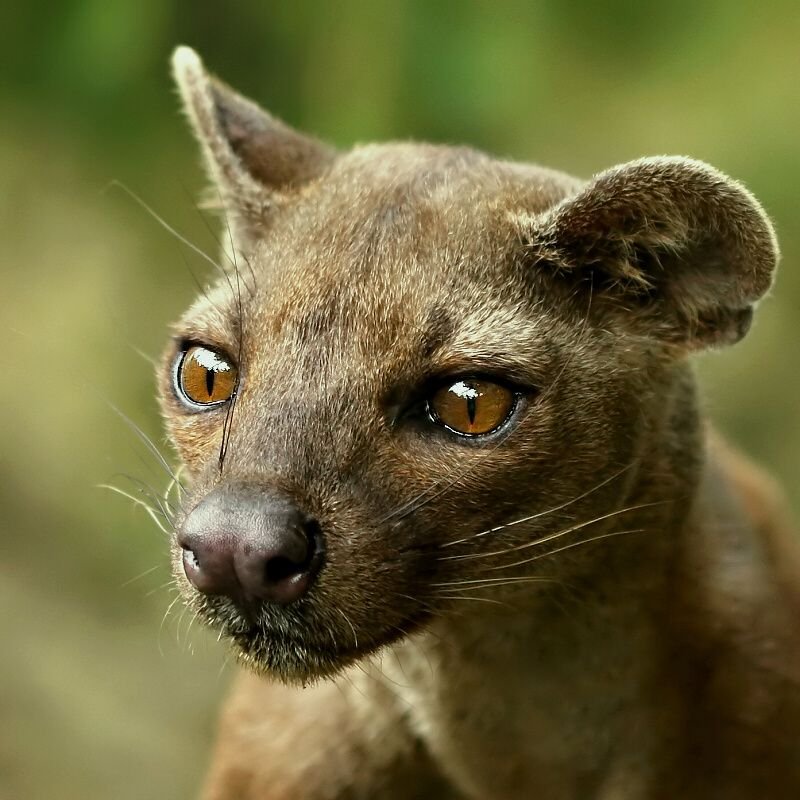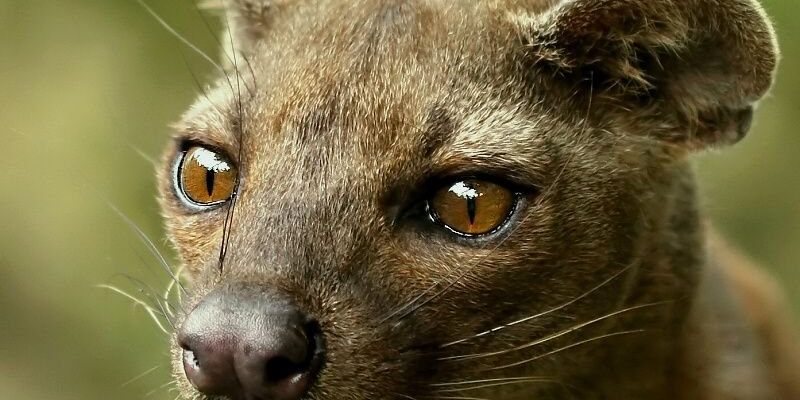
The fossa, with its long body and agile limbs, is an apex predator in its native Madagascar. Its life revolves around the dense rainforests, where it’s perfectly adapted to thrive. You might be wondering what sets the fossa apart from other animals that also call Madagascar home. Well, let me explain! This creature is not just a curious sight; it plays an important role in the ecosystem of the island. So, let’s unravel some exciting facts about the fossa that might just make you fall in love with this charming animal.
1. The Fossa’s Unusual Family Tree
You might be surprised to learn that, despite its cat-like appearance, the fossa is more closely related to the mongoose than to any felines. This can be a bit confusing since they look so similar to a small cougar! The fossa belongs to the family Eupleridae, which is endemic to Madagascar, meaning these animals are found nowhere else in the world.
To put this into perspective, think of how humans are distantly related to chimpanzees but have very different physical traits. Similarly, the fossa shares its lineage with creatures like the ring-tailed lemur and the binturong. This unique evolution is part of what makes Madagascar such a hotspot for biodiversity.
2. Expert Climbers and Hunters
Fossas are built for agility and speed. They have strong limbs and long tails that help them navigate the complex canopy of Madagascar’s forests. Their huge, sharp claws enable them to climb trees with impressive skill, often leaping from branch to branch in search of their favorite snack: lemurs!
Speaking of hunting, the fossa is a solitary predator, meaning it hunts alone. They are incredibly stealthy and can take down prey larger than themselves. Imagine watching a skilled acrobat—this is how a fossa moves through the trees, showcasing its physical prowess in every leap and bound.
3. Unique Communication Styles
If you think communication is limited to birds chirping or dogs barking, the fossa might just change your mind. They have a range of vocalizations that vary from growls to high-pitched screams, resembling a mix between a cat and a dog. It’s fascinating to realize that these sounds serve as critical signals to other fossas, especially during mating season.
When a male fossa is trying to attract a female, he’ll often emit a series of calls that can be heard from quite a distance. In a way, it’s almost like their own musical performance, showcasing their strength and desirability in the wild.
4. Diminishing Habitat and Conservation Efforts
Unfortunately, the fossa faces a serious threat due to habitat loss. Madagascar’s precious rainforests are disappearing because of deforestation for agriculture and logging. It’s estimated that about 90% of the island’s original forest cover has been lost. This affects not only the fossa but many other unique species that inhabit these ecosystems.
Conservation efforts are underway, however. Many organizations are working diligently to protect Madagascar’s wildlife, including the fossa. Creating protected areas and promoting sustainable practices can help ensure that future generations might still marvel at this unique creature.
5. Interesting Reproductive Habits
Fossas have a unique breeding season that usually peaks between September and December. During this time, males will compete for the attention of females. This often leads to loud vocal displays and aggressive posturing as they establish dominance.
Once mating occurs, the female will give birth to a litter of two to four cubs after a gestation period of about three months. The young fossas are born blind and helpless, relying on their mother for nourishment and protection. Watching these little ones grow is a reminder of how precious life is in the wild.
6. Diet and Hunting Techniques
The fossa is truly an omnivore but has a particular affinity for lemurs. They also munch on birds, reptiles, and small mammals. With their keen sense of sight and smell, fossas are expert stalkers, able to sneak up on their prey before launching into a swift attack.
Here’s the thing: the fossa’s diet is quite adaptable. If lemurs are scarce, they’re not shy about turning to other food sources. This flexibility is crucial for survival in Madagascar’s changing forests.
7. The Fossa’s Role in the Ecosystem
As an apex predator, the fossa plays a vital role in maintaining balance in its ecosystem. By keeping lemur populations in check, fossas help ensure that the vegetarian plants don’t get overgrazed. This contributes to the overall health of the forest environment.
Without the fossa, the ecosystems within Madagascar could face severe imbalances, demonstrating just how interconnected nature is. The next time you hear about a food chain, think of the fossa as a key player in the grand scheme of things.
8. Cultural Significance and Folklore
In Madagascar, the fossa holds a special place in the local culture and folklore. Some stories depict the fossa as a mythical creature, embodying strength and agility. Locals often share tales about fossas, weaving them into their rich tapestry of traditions.
These stories not only celebrate the fossa but also elevate understanding of wildlife conservation. By fostering appreciation for this unique animal, they promote efforts to protect its habitat, ensuring that future generations will continue to appreciate their cultural significance.
9. How to Spot a Fossa in the Wild
If you’re ever lucky enough to visit Madagascar and want to catch a glimpse of a fossa, there are a few tips that could help. The best time to spot them is during the early morning or late afternoon when they’re most active.
Fossas are elusive, so your best chance is in protected areas like Andasibe-Mantadia National Park. Look for them climbing trees or resting on branches—disguised in the dappled sunlight filtering through the leaves. Just remember to keep your distance and respect their wild nature.
10. Why the Fossa Matters
In a world where many species are at risk of extinction, the fossa is a symbol of Madagascar’s incredible biodiversity. Protecting this unique predator means protecting an entire ecosystem with countless other species relying on it.
By learning about the fossa and advocating for its conservation, we take steps toward appreciating and safeguarding nature’s wonders. This matters because it helps foster a healthier planet for all living creatures.
In conclusion, the fossa is far more than just a curious animal with a unique appearance. It’s a vital player in Madagascar’s ecosystem, a fascinating creature with a rich history, and a compelling symbol of conservation efforts. Whether you’re an animal lover or simply curious about the natural world, the fossa certainly deserves a spot on your radar!

